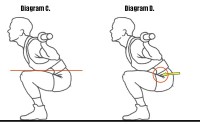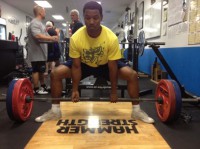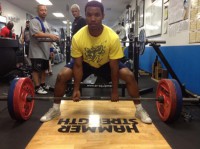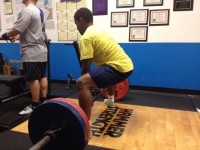This is a technique I use with some of my lifters to increase their confidence on the bench press. It’s not a new idea, and people have been using it since the dawn of time, but it’s something we haven’t discussed on the site, and I get a lot of questions about it. I call it the “Over Warm-Up (OWU).” It’s a very technical and marketable name, I know. What does it mean? What do you think it means? It means you warm up to a heavy single before your work sets. Complicated stuff.
It might not have a sexy name, but it works. I’ve used this with a quite a few lifters to build confidence on heavy benches and to get them past long-term sticking points. In the past few months, RoryT used it to go from a 285 max bench to hitting 300 for the first time, then a couple weeks later, crushing 300×2. Jess used this technique to handle 95lbs dozens of times before her meet last weekend, where she hit two easy Meet Bench PRs. Many guys over on the LHS Forums are using it with success. You could also use it for various other lifts, like presses, push presses, even squats – though I think it’d be a pretty terrible idea on deadlifts. The target audience for this approach will be primarily novices and intermediates. If you’re an advanced lifter, chances are you’re not likely to benefit much from it, as you’ve already had years to master the mental aspects of the main lifts, and you’re quite capable of getting psyched up for a heavy PR single.
However, many lifters will find themselves “nervous” about certain weights, especially in the beginning stages of getting stronger. Typically, these hurdles revolve around a combination of big plates and 25lb plates. The weights I’m talking about here are usually 185, 225, 275, 315, 365, 405, etc., though the OWU can be used for any mental sticking point (the 200 and 300lb benchmarks can be just as intimidating as any other, even though they don’t look that special on a bar), or even just to include some heavy practice.
I can’t stress enough that you have a partner lift/spot your OWU, especially as you first tinker with it. Never pick a weight you can’t handle – if you are EVER missing a rep on your OWU, you’re doing it way, way wrong. You need to pick a weight that is well within reach – it’s not supposed to tire you out, or require a psych-up. It’s not an excuse to get greedy and “max out.” It’s just something to stomp on until it’s dead. Then you move on to the next enemy, and stomp it. Here are a few examples of how I implement it.
Example A: The Novice
Most novices should be on a simple linear progression, and our imaginary example is benching every other workout for 3×5 (or 3×5+, going for max reps on the last set). Let’s say they’ve gotten their LP from 165 for 3×5 to 212.5 for 3×5, and they’re now adding 2.5lb (or less) per workout and trying their damn hardest to continue progressing, with visions of 300+ in their head. This person would normally warm up to 212.5 like so:
45 x Lots, 95×5,5, 135 x 5, 185×2-3, 200×1, Work Sets @ 212.5.
Adding in an OWU at 225 is perfect for this person. Not only will they get used to handling 2 plates, they will KNOW they can hit it any day of the week, helping them feel more confident about getting up to it for their 3×5 work. Their warmup would now look roughly like this:
45 x Lots, 95×5,5, 135 x 5, 185×2-3, 205×1, 225×1 (OWU), Work Sets @ 212.5.
They would use 225 as their OWU for a few weeks until it was laughably easy, or until their work sets have actually caught up to that level (in this case, 225). At that point, they can either ditch the OWU for awhile, or move it up in 5-10lb increments if they enjoy feeling a bit heavier singles before their work sets.
Again, please note that a proper OWU is NOT heavy enough to constitute a large amount of work. It should not be a grinder. It should not impede the lifter’s ability to perform their work sets. Take a few minutes of rest after the OWU before your work sets, just as you would after your final normal warmup.
Example B: The Intermediate
Let’s say we have a typical intermediate lifter using the Texas Method. He got his linear progression from 205 3×5 up to 245 for 3×5 after a couple months of hard work and proper dieting and too many resets. He’s gone from benching around 225 for a single to around 285 or so on a good day, but something about 275+ just makes him a bit nervous. On his Intensity Day, he’s trying for 5RM’s in the 255 range, and his Volume Day is starting at 225 3×5, because he refuses to use less than 2 plates for his Volume Day.
This lifter should utilize the OWU on their Volume Day, but not on their Intensity Day. In this case, I would have them work up to 275 and then backing down to their work sets. It would look something like this:
45 x Lots, 135 x 5,5, 185×5, 225×1-2, 255×1, 275×1 (OWU), 225×5,5,5
The lifter would NOT use the OWU on their Intensity Day, as they should conserve every bit of energy they have for a big PR. The Intensity Day would still look like this:
45 x Lots, 135 x 5,5, 185×5, 225×1-2, 255×5 (PR)
Note: I prefer TM lifters to use as little supportive gear on their Volume Day as possible when they’re a ways out (IE, more than 6-8 weeks) from a meet. This means they would usually use no belt or wrist wraps on VD for bench, even if they use them on ID. The OWU is an exception – it would be acceptable to “gear up” for it, especially when first implementing it. Of course, keep in mind 132lb Jennifer Thompson doesn’t wear a belt for her 300+ raw bench, so…just sayin’. After a few weeks of using wrist wraps and a belt with 275, the lifter could then practice dropping the gear, or slowly increasing the weight of the OWU. Preferably, they’ve decided to enter a meet, which leads us to…
Example C: The Competitor
Another great use for the OWU is to practice some simple raw paused work on the bench, especially near a meet (starting 4-6 weeks out or so would be appropriate). Again assuming a typical TM template with a Vol/Int day each week, I would also have this lifter use the OWU on their Volume Day before their work sets, but in this case, I would have them practice their opening (paused) bench attempt. This is an excellent way to add in some practice getting used to the commands. It’s particularly helpful for USAPL lifters who might experience long “start” and “rack” commands, depending on the judge. As they get closer to a meet, the pause should be slightly longer, and the speed coming off the chest should be noticeably improved. At the meet, they’ll have 100% confidence in their opener.
The OWU is a tool that can be used effectively. It is by no means required in all successful programs, but give it some consideration, and feel free to play with it in your own programming. You might like it, and hopefully, it will lead to lots of new PRs.







